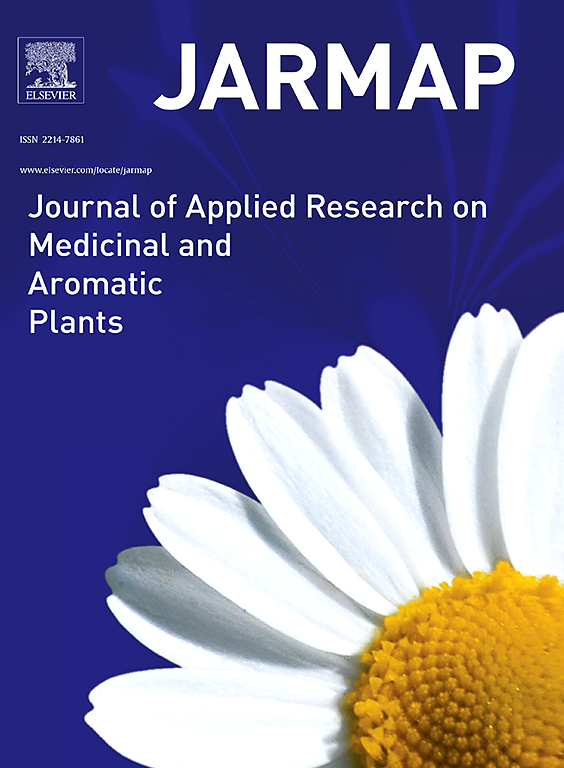Agronomical and biotechnological strategies for modulating biosynthesis of steviol glycosides of Stevia rebaudiana Bertoni
IF 3.6
2区 农林科学
Q1 PLANT SCIENCES
Journal of Applied Research on Medicinal and Aromatic Plants
Pub Date : 2024-09-24
DOI:10.1016/j.jarmap.2024.100580
引用次数: 0
Abstract
Steviol glycosides (SGs), the diterpenoids group of plant secondary metabolites, possess phytopharmaceutical properties. Steviol glycosides are principally obtained from the stevia (Stevia rebaudiana) plant, which belongs to the Asteraceae family. Nowadays SGs are mainly used in the food and beverage industries as a non-caloric natural sweetener, which is about 300 times sweeter than sucrose. Among the known SGs, stevioside, and rebaudioside-A are the most abundant in the stevia leaf. Recent studies have shown that agronomic and biotechnological factors principally govern the accumulation of SGs in stevia plants. Therefore, to meet the burgeoning demand for SGs, efforts have been made to modulate the biosynthesis of these bioactive compounds in stevia using different agronomic and biotechnological strategies. In this review, we lucidly discussed agronomic and biotechnological approaches that stimulate and enhance the biosynthesis of SGs in stevia. Detailed mechanistic information could support us in making a plan for the production of SGs through stevia cultivation. We also outline some promising areas for future research that would inspire studies aiming to understand the consequence of interaction effects among the environmental and agronomic factors for the biosynthesis of SGs.
调节 Stevia rebaudiana Bertoni 甜菊糖苷生物合成的农艺和生物技术策略
甜菊醇苷(SGs)是植物次生代谢产物中的二萜类,具有植物药特性。甜菊醇苷主要取自菊科植物甜叶菊(Stevia rebaudiana)。目前,甜菊糖主要用于食品和饮料行业,是一种无热量的天然甜味剂,其甜度约为蔗糖的 300 倍。在已知的甜菊糖中,甜菊糖甙和甜叶菊甙-A 在甜菊叶中含量最高。最近的研究表明,甜叶菊植物中 SGs 的积累主要受农艺和生物技术因素的影响。因此,为了满足对甜叶菊 SGs 不断增长的需求,人们一直在努力采用不同的农艺和生物技术策略来调节甜叶菊中这些生物活性化合物的生物合成。在这篇综述中,我们清晰地讨论了刺激和加强甜叶菊中 SGs 生物合成的农艺和生物技术方法。详细的机理信息可帮助我们制定通过甜叶菊种植生产 SGs 的计划。我们还概述了一些有希望的未来研究领域,这些领域将激励旨在了解环境和农艺因素之间相互作用对 SGs 生物合成的影响的研究。
本文章由计算机程序翻译,如有差异,请以英文原文为准。
求助全文
约1分钟内获得全文
求助全文
来源期刊

Journal of Applied Research on Medicinal and Aromatic Plants
Pharmacology, Toxicology and Pharmaceutics-Drug Discovery
CiteScore
6.40
自引率
7.70%
发文量
80
审稿时长
41 days
期刊介绍:
JARMAP is a peer reviewed and multidisciplinary communication platform, covering all aspects of the raw material supply chain of medicinal and aromatic plants. JARMAP aims to improve production of tailor made commodities by addressing the various requirements of manufacturers of herbal medicines, herbal teas, seasoning herbs, food and feed supplements and cosmetics. JARMAP covers research on genetic resources, breeding, wild-collection, domestication, propagation, cultivation, phytopathology and plant protection, mechanization, conservation, processing, quality assurance, analytics and economics. JARMAP publishes reviews, original research articles and short communications related to research.
 求助内容:
求助内容: 应助结果提醒方式:
应助结果提醒方式:


